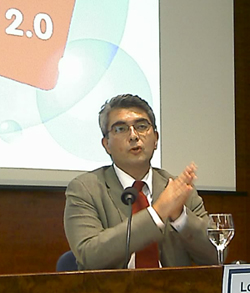By Ismael Peña-López (@ictlogist), 21 October 2008
Main categories: Digital Literacy, e-Government, e-Administration, Politics, ICT4D, Meetings, Participation, Engagement, Use, Activism
Other tags: e-government 2.0, egov_epfl
No Comments »
ICTs, development and e-government 2.0: empowering the citizenry
Presentation
Recommended Readings
Noveck, B. S. (2008). “
Wiki-Government”. In
Democracy, Winter 2008, (7), 31-43. Washington, DC: Democracy, a Journal of Ideas, Inc..
Assignment
Find and choose an e-government, political or civil society project based in Web 2.0 applications (blogs, wikis, social bookmarking, social networking sites, etc.).
Briefly describe it, stating its purpose, who is running the project, what technology is using, etc. and what difference does it make (i.e. what innovation or added value does it bring) to the status quo.
Answer ‘yes’ or ‘no’ to the following answers (based on Zuckerman’s Innovation Test) briefly stating the reasons for your answer:
- Does the innovation come from constraint?
- Does it fight culture?
- Does it embrace market mechanisms?
- Does it innovate on existing platforms?
- Does it come from close observation of the target environment?
- Does it focus more on what you have more that what you lack?
- Is it based on a “infrastructure begets infrastructure” basis?
Evaluation criteria:
- Identification of main/critical aspects
- Depth of analysis, conclusions backed with data/evidence…
- Use (and citation) of appropriate and complementary references
- Quality of exposition, structure, clarity of language…
More information
By Ismael Peña-López (@ictlogist), 02 June 2008
Main categories: Cyberlaw, governance, rights, e-Government, e-Administration, Politics, Meetings, Participation, Engagement, Use, Activism
Other tags: e-gov 2.0, e-government 2.0, idp2008, lorenzo cotino
No Comments »
Notes from the 4th Internet, Law and Politics Congress.
Session IV
Chairs: Agustí Cerrillo, Law Professor, UOC
Conference
Lorenzo Cotino
Electronic public services: e-government 2.0 The Regulation of E-Government 2.0
Law goes really behind the speed of times. The problem is that Law, or Administrative Law, faces challenging reality: .com can fail, but .gov cannot”
.
At the legal level, the big challenge of the Web 2.0 is the integration of content produced by third parties in another platform — or your content put in a platform run by a third party.
 Lorenzo Cotino
Lorenzo Cotino
Some things that e-Gov 2.0 can bring: G2C
- More information
- Transparency
- Participation
Some things that e-Gov 2.0 can bring: C2G
- Best of feedbacks
- Crest of the wave innovation of early adopters
- Law enforcement by citizens: reports, complaints, etc.
Some things that e-Gov 2.0 can bring: G2G
- Share knowledge, bottom up
Some things that e-Gov 2.0 can bring: C2C
Incentives of e-Gov 2.0: motivation, fostering, training. P2P training a successful bet.
The role of Law in e-Gov 2.0 is to bring security to the whole system, and guarantee the citizen’s rights. E.g. not all has to be that transparent, as there are privacy issues concerned.
Some rights:
- Guarantee a contact address
- Compulsory information
- Usability
- Feedback mecanisms
One of the biggest problems we nowadays have in the Internet is anonymity: who’s liable for some published content? And not only anonymity, but the easy flow of content from one place/platform to another one. This is a threat for the development of the e-Administration. Though some anonymity can be good in some aspects of citizenship.
4th Internet, Law and Politics Congress (2008)

 , 10 MB)
, 10 MB)
